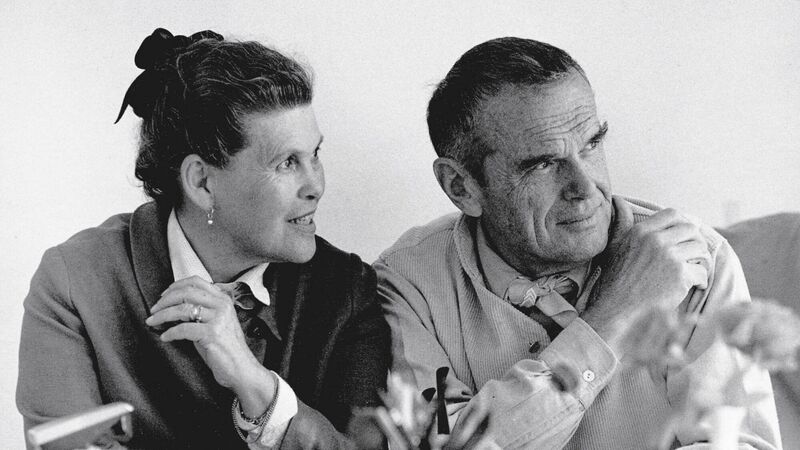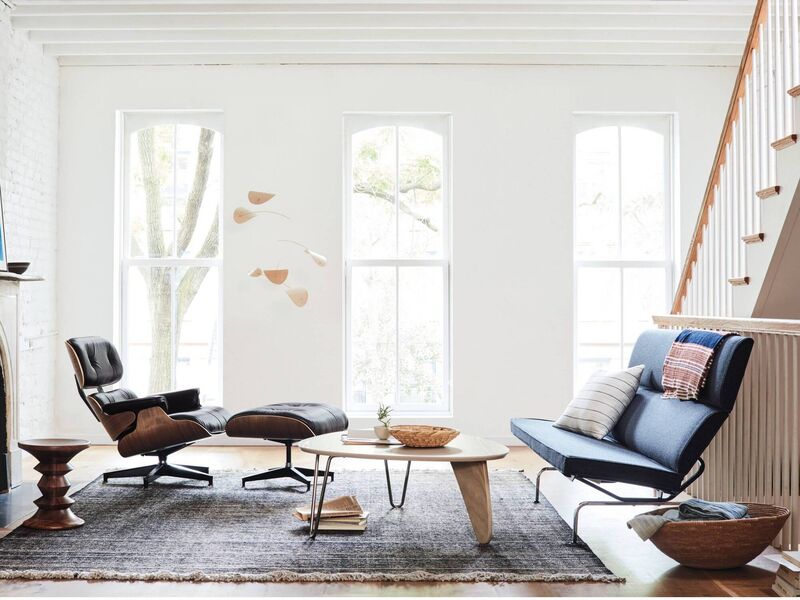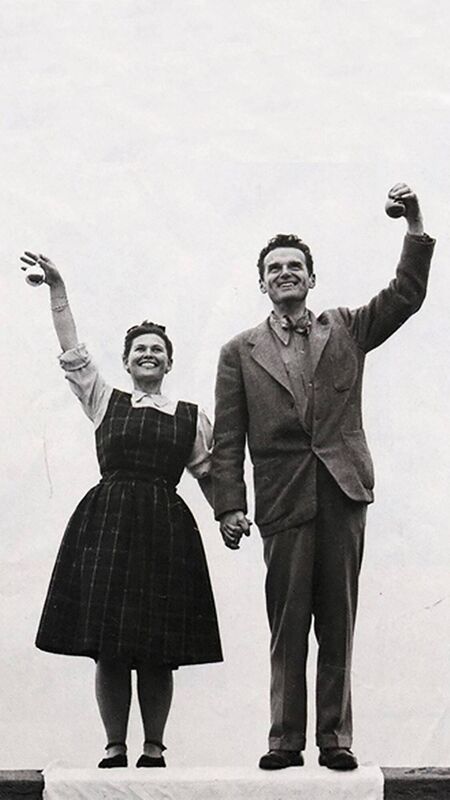Timeless design partnership of Charles and Ray Eames

Charles and Ray Eames in the 1970s. Picture: vitra.com
Bobbing on a battered aluminium group chair that collides rudely with this knee-hole desk, I’m heady just writing about the romance and creative expressions of Charles and Ray Eames. As my teen puts it while perusing a photograph of the pair — “relationship goals”.
If it was all just cynical, newspaper puff tailoring the cream cheese smiles of this design duo in each other’s arms — I never, ever want to know.

In 1930 at the age of just 23, Charles Eames (1907-1978) was married and a father, and had established an architectural partnership with Charles Gray and Walter Pauley. Precocious and brilliant, he had trained in engineering and architecture in Washington University in St Louis, reprimanded by his tutors over his advocacy of stark European-led modernism, and his insurrectionist enthusiasm for the eclectic American architect Frank Lloyd Wright.
Having bailed on a formal education after a mere two years due to the pressure of paid design work, he was recruited to head of industrial design at the Cranbrook Academy of Arts in Michigan, where he would meet his lifelong friend Finnish-American architect Eero Saarinen and his father Eliel.
In 1940, the Museum of Modern Art held an “Organic Furniture Competition”.
A striking, joy-rich former art student at Cranbrook, Ray (Bernice) Kaiser (1912-1988), became involved in the graphic design work on Eero and Charles’ (winning) entry. Charles and Ray’s personal relationship ignited (appropriately) while drawing up pieces in moulded plywood. Kindred souls at every level, within a year his first marriage imploded, and Eames filed for divorce.
His proposal letter to Ray reads: “Dear Miss Kaiser, I am 34 years old, single (again) and broke (under-lined). I love you very much and would like to marry you very, very soon. Soon means very soon. I cannot promise to support us very well.” He finishes with a sketch of a hand, with an arrow pointing to the ring finger, with the inquiry, “what is the size of this finger-tip?”
He had her measure, and their passion and creativity would go on to twine their names personally and professionally for the next four decades and beyond — the aesthetic king and queen of American Mid-century modern.

Riding on a can-do cloud of love, talent and confidence they ran away from their former responsibilities back to Ray’s native state of California, where Charles had no professional credentials, including the critical stamp of an architectural license.
Settling in LA, they were uniquely unqualified but brave as lions. Charles would remain a potent force in his daughter Lucia’s life and apart from her own remarkable design accomplishments, Lucia would continue to guard the Eames legacy until her death in 2014, founding the Eames Foundation in 2004.
Charles and Ray proved to be nimble design opportunists, delivering on US Navy contracts for highly effective plywood stretchers and splints (their partnership with a team under the Moulded Plywood Division under the famed Colonel Evans). Charles even contributed to ideas for plane parts for the aerospace division after the US entered the Second World War.
While he worked as a set architect for the film studio MGM, Charles and Ray moonlighted under even the threat of eviction on their plywood furniture designs with their Kazam moulding machine from a guest room at the inspiring Strathmore Apartments designed by Richard Neutra in LA.
By 1943, they had begun working from their 901 Washington Avenue address, and Evans Products exhibition at MoMA in 1946 would give the pair a chance to show off their radical but beautiful furnishings in NY. They participated in the 1945-1962 Case Study House Program of John Entenza, editor of Art & Architecture magazine.
Charles and Eero Saarinen began developing the humanist home come studio (known as Case Study 8 or the Bridge House) which deployed the best of new materials and techniques in minimalist domestic design in the Pacific Palisades.
Ray had more input than originally intended in the home’s design as the couple camped out on the cliffs of the Palisades, pushing Saarinen completely out of the plans in the end. Enclosed in each other’s company the Eameses found their house conjured in the views and surrounding natural environment, something especially close to Ray’s heart from childhood.
With a steel frame visible indoors — that was something completely new for 1947, concrete slab roof, birch panelling and acres of glass — it democratised a sort of new Bauhaus-led spare chic, summing up much of what Charles and Ray were exploring in their furnishing work. Popular, functional, accessible and blistering with style.
They clearly got their own house right, first time, as their “old cave” remained their first and last forever home. Ray remarked, “What works good is better than what looks good because what works good — lasts.”
At the heart of it all is the surprising restraining ethic attached to Charles that “innovation was the last resort”. Something new should only be introduced if there was a really good reason to do it.
“We don’t do art; we solve problems,” he later wrote. They both dressed in relaxed almost Boho semi-formal for the time. Their furniture for Herman Miller, Vitra and IBM, whatever the form was intended to be, equally comfortable whether deployed in a Manhattan corporate board room or a Laurel Canyon lounging pit.
The Eames House, together with Entenza’s house next door was covered by magazines across the design world. Its bold energy was supped up by the exhausted spiritually battered Americans longing to put the war years behind them.
It was a home first and foremost, the ceilings of the house clouded in hanging tumbleweed collected by the couple on their honeymoon road-trip to California in 1941.
Ray suspended paintings downward from the rafters so they could be enjoyed even lying on the floor.
Ray’s contribution to the Eames legacy was shadowed by the tall imposing frame of her husband until the 20th century and swallowed up in their collaborative successes. Sidelined as a Girl Friday by onlookers, a surviving TV interview for the 1956 Home Show painfully displays this public perception in wincing motion as she’s dismissed from the stage.
Ray was a multi-talented creative and business person providing the crucial insight and final gentling polish on the collection. More recently her legacy has been re-explored and celebrated.
A filmmaker, designer and artist in her own right, Ray’s graphic art and commercial designs including her textiles are now receiving a lot of attention. Sadly Ray’s expressionist paintings from her time under the tutelage of Hans Hoffmann in New York have all but disappeared.
Charles Eames always recognised Ray as his primary and most precious asset. His greatest compliment to his devoted partner and powerhouse wife was one brief, perfectly drawn line of love and generosity: “Anything I can do, Ray can do better.”

Unlimited access. Half the price.
Try unlimited access from only €1.50 a week
Already a subscriber? Sign in
CONNECT WITH US TODAY
Be the first to know the latest news and updates









